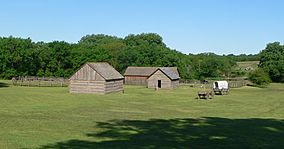Rock Creek Station facts for kids
Quick facts for kids Rock Creek StationState Historical Park |
|
|---|---|

Reconstructed buildings at East Ranch
|
|
| Location | Jefferson County, Nebraska, United States |
| Nearest town | Endicott, Nebraska |
| Area | 353 acres (143 ha) |
| Elevation | 1,371 ft (418 m) |
| Designation | Nebraska state historical park |
| Established | 1980 |
| Administrator | Nebraska Game and Parks Commission |
| Website | Rock Creek Station State Historical Park |
Rock Creek Station was an important stop for stagecoaches and the Pony Express in southeastern Nebraska. It is located about three miles northeast of the village of Endicott. Today, this historic place is protected as Rock Creek Station State Historical Park. It helps us remember a busy time in American history.
Contents
A Look at Rock Creek Station's Past
How Rock Creek Station Began
Rock Creek Station started in 1857. S.C. Glenn built it on the west side of Rock Creek. It was a vital stop along the famous Oregon Trail and California Trail. Many pioneers, called emigrants, traveled these trails heading west. The station offered them supplies and a place to camp.
Changes and a Toll Bridge
In March 1859, David McCanles and his brother, James, bought the property. They added a special feature: a toll bridge over Rock Creek. Travelers had to pay a small fee, from 10¢ to 50¢, to cross the bridge. The amount depended on how much they could afford. In 1860, McCanles built a cabin and dug a well on the east side of the creek. This area became known as the East Ranch.
The Pony Express Arrives
In early 1861, the McCanles family sold the East Ranch. It was bought by a company that owned and ran the Pony Express. This company was formed by Russell, Waddell, and Majors. The Pony Express was a fast mail service that used horseback riders. The McCanles family continued to live and work at the West Ranch. It remained a rest stop for pioneers.
A Famous Confrontation
In July 1861, David McCanles visited Rock Creek Station. He wanted to discuss a payment that was late. An argument turned violent, and McCanles died during a confrontation with a young James Butler Hickok. Hickok later became known as the legendary Wild Bill Hickok. This event became a famous story of the Old West.
Rock Creek Station State Historical Park Today
Exploring the Park
In 1980, the Nebraska Game and Parks Commission created Rock Creek Station State Historical Park. The park covers about 350 acres. An additional 40 acres nearby is a state recreation area. Visitors can still see deep ruts in the ground. These ruts were made by thousands of wagons traveling the historic trails.
What You Can See and Do
The park has rebuilt the old toll bridge and many of the station's buildings. This helps visitors imagine what it was like long ago. There is also a visitor center with interesting exhibits. You can learn about the pioneers on the Oregon Trail and the story of Wild Bill Hickok. The park offers hiking trails and a campground for visitors. It's a great place to learn about history and enjoy nature.
See also



